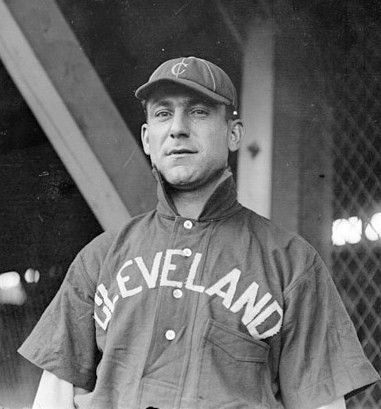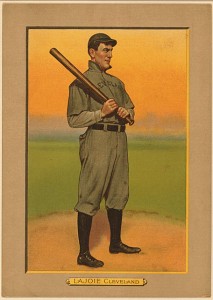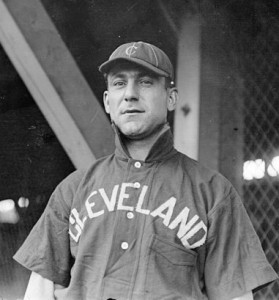Historical Hitter September 27: Nap Lajoie

In the long history of the game, I know of four people who have teams named for them. Two are indirect, and three more direct. For the indirect names we start in the 1880’s with the National League Gothams being renamed after a rousing victory against the Phillies, and a giant of the times, Roger Conner, a past Batter of the day. Then comes the  team with many names: the Boston Nationals (aka Red Caps, Red Stockings, Red Sox, Pilgrims, Beaneaters, Bees, Braves); for a time this team was known as the Boston Doves, after the owners of 1907 the Dovey Brothers. It’s perhaps a good thing they did not follow this tradition and rename their name after more recent owner: Ted Turner. The Dodgers were named the Robins for a time after their manager Wilbert Robinson (of course this was a double meaning since it’s a bird and then a color too). One American League team was not exempt from a lack of good names either. The Cleveland franchise also has gone through a series of names Blues, Spiders, Bronchos, Americans etc. before choosing the name Indians. In the early years of the twentieth century this team was called the Naps after their best player and captain. Napoleon Lajoie. Just think of what would have happened if Derek Jeter was drafted by Cleveland – besides Keith Olbermann having a cerebral blowout.
team with many names: the Boston Nationals (aka Red Caps, Red Stockings, Red Sox, Pilgrims, Beaneaters, Bees, Braves); for a time this team was known as the Boston Doves, after the owners of 1907 the Dovey Brothers. It’s perhaps a good thing they did not follow this tradition and rename their name after more recent owner: Ted Turner. The Dodgers were named the Robins for a time after their manager Wilbert Robinson (of course this was a double meaning since it’s a bird and then a color too). One American League team was not exempt from a lack of good names either. The Cleveland franchise also has gone through a series of names Blues, Spiders, Bronchos, Americans etc. before choosing the name Indians. In the early years of the twentieth century this team was called the Naps after their best player and captain. Napoleon Lajoie. Just think of what would have happened if Derek Jeter was drafted by Cleveland – besides Keith Olbermann having a cerebral blowout.
Lajoie had a stellar 21- year career that spanned from 1896 to 1916. He was a career .338 hitter with an OPS+ of 150. He was a player with few peers and was respected and liked by the rest of the league.
Today’s batter of the day is the man that that a team was named after: Napoleon Lajoie. His line was 2 for 3 with two doubles, with two runs scored. In a season where his team lost 100 games, it was no doubt a season highlight.
 Being the Hall of Famer that he was, he reached his 3000th hit today in style. While we do not have a play by play, we know that on this day he hit a career number of doubles and lead his team to victory over the New Yorkers. The Sporting Life box score with the note of Lajoie’s 3000 hit being a double. The ball was taken out of play and given to Lajoie which helped establish the tradition of keeping special artifacts some two decades before the Hall of Fame was created.
Being the Hall of Famer that he was, he reached his 3000th hit today in style. While we do not have a play by play, we know that on this day he hit a career number of doubles and lead his team to victory over the New Yorkers. The Sporting Life box score with the note of Lajoie’s 3000 hit being a double. The ball was taken out of play and given to Lajoie which helped establish the tradition of keeping special artifacts some two decades before the Hall of Fame was created.
Doubles were his forte, his career total of 657 doubles was the MLB record when he retired. This record has been surpassed by only six other major leaguers, including compatraites Speaker, Cobb, and Hall of Famers Stan the Man and George Brett, and fellow second baseman and hopefully hall of famer, Craig Biggio.
He was the American League’s first superstar: a larger than life player being 6-1 and 200 pounds, he towered over the opposition and his teammates. In the field he was unmatched noted for being very graceful, quick on his feet, had a powerful arm, and noted for covering ground like a deer.
“Lajoie glides toward the ball,” noted the New York Press, “… gathers it in nonchalantly, as if picking fruit….” During his 21-year career, Lajoie led the league in putouts five times, assists three times, double plays five times, and fielding percentage four times.
During the 1909 season, his popularity led to controversy. He was locked in a tight battle with the Cobb for the batting title. On the last game of the season, his opposition manager, who detested Cobb ordered the Browns rookie 3rd baseman to play deep almost in left field allowing Lajoie to bunt his way to 7 infield hits to the title. A week later, after Cobb sent a congratulatory letter to Lajoie, American League President Ban Johnson intervened, and declared Cobb the winner. The Chamlers Car company who gave out the award, actually gave two cars to both players. The controversy lasted until 1981 when SABR research uncovered a double counting for Cobb, but Bowie Kuhn did not overturn the older record and still gave the title to Cobb.
 His best season was his first in the American League, he hit .428 en route to winning the triple crown. This batting average set in the initial year of the American League has never been topped.
His best season was his first in the American League, he hit .428 en route to winning the triple crown. This batting average set in the initial year of the American League has never been topped.
He was elected to Hall of Famer from the Class of 1937, some two years before the Hall of Fame was opened. His career numbers are staggering, 3248 hits with five or six batting titles, was a five-time leader in doubles, a four-time league leader in hits, total bases, slugging, and a three time leader in RBI’s, OPS and OPS+. Recent SABR researcher note that part of his success was a special bat
His bat, designed by the J.F. Hillerich Company, had two knobs at the end, which enabled him to perfect his split-hands grip. It gave Nap great bat control and allowed him to place the ball where he wanted almost at will. It was the true art of hitting before home runs were in vogue.
On this day, as his career was winding down, the first superstar of the American League reached the sacred platuea of 3000 hits, and he did so in style, with his signature hit a double. And like all superstars, his hits lead his team to victory.
